If you’re looking for a new 3D printing project or if you’re a fan of model trains, this list might be just what you’re looking for. In this article, we’ve brought together some projects from established model train sets such as Brio and Lego Duplo. We’ve also included models from the OpenRailway Project, which is an ambitious open-source initiative that looks to bring more free model trains to the world.
From creative locomotives and fun accessories to full-on railway systems, you can choose the ones you like best and try your hand at printing them. If you want to skip the printing and jump right to building your model train universe, consider giving Craftcloud a try. You can simply upload the model(s) you want, pick your materials and shipping preferences, and Craftcloud’s professional 3D printing partners will do the rest.
Now, with all of that out of the way, let’s take a ride!
Locomotives & Wagons
To start, let’s get right to the good stuff: the trains themselves! The following designs are a sampling of some fantastic locomotives and wagons, from accurate historical models to recreated toys.
Stephenson's Rocket
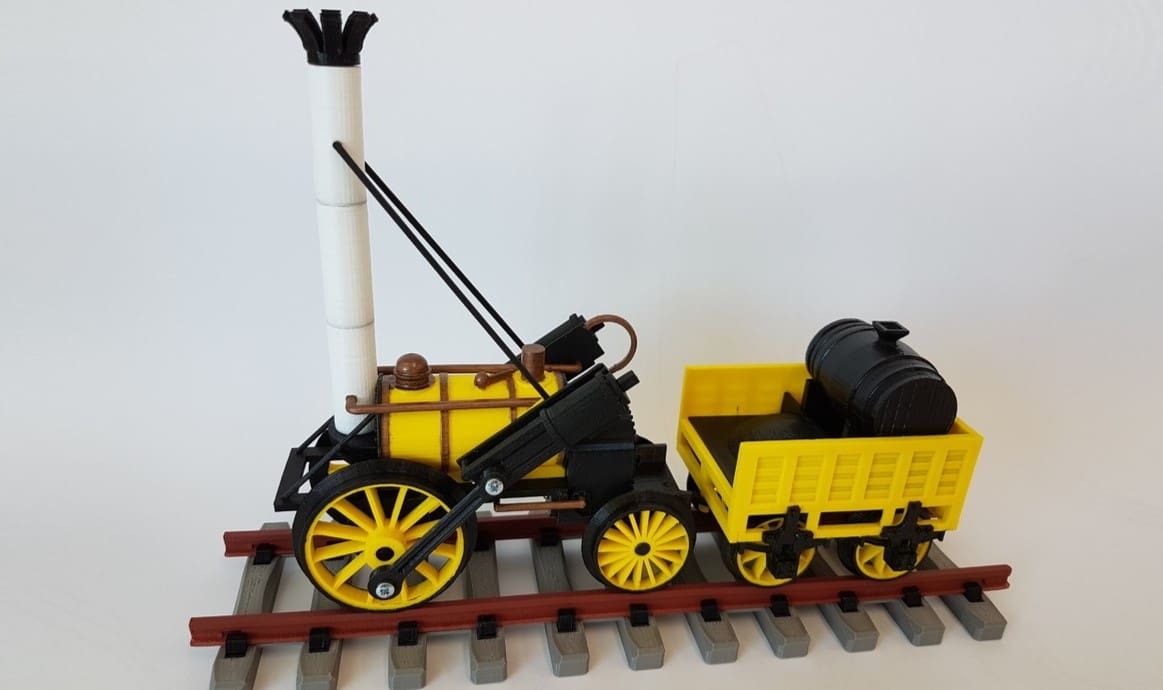
Stephenson’s Rocket was an early steam locomotive built for the Rainhill Trials, a competition held in October 1829 to test whether improved locomotives would be more efficient than stationary steam engines. As the only locomotive to complete the competition, Stephenson’s Rocket was declared the winner.
This model of the champion locomotive is 25 cm long and was originally printed in 1.75-mm diameter ABS. Only one of the parts requires supports. For assembly, make sure you have four small screws and glue or acetone handy, depending on your material of choice.
- Who designed it? UtjTrain
- How printable/popular is it? So far, 39 people have shared makes of this locomotive, and they all look remarkable – as do the 3 remixes!
- Where to get it? Thingiverse
- What’s the compatible train set? OpenRailway, 1:32 scale
EMD SW1500 Locomotive
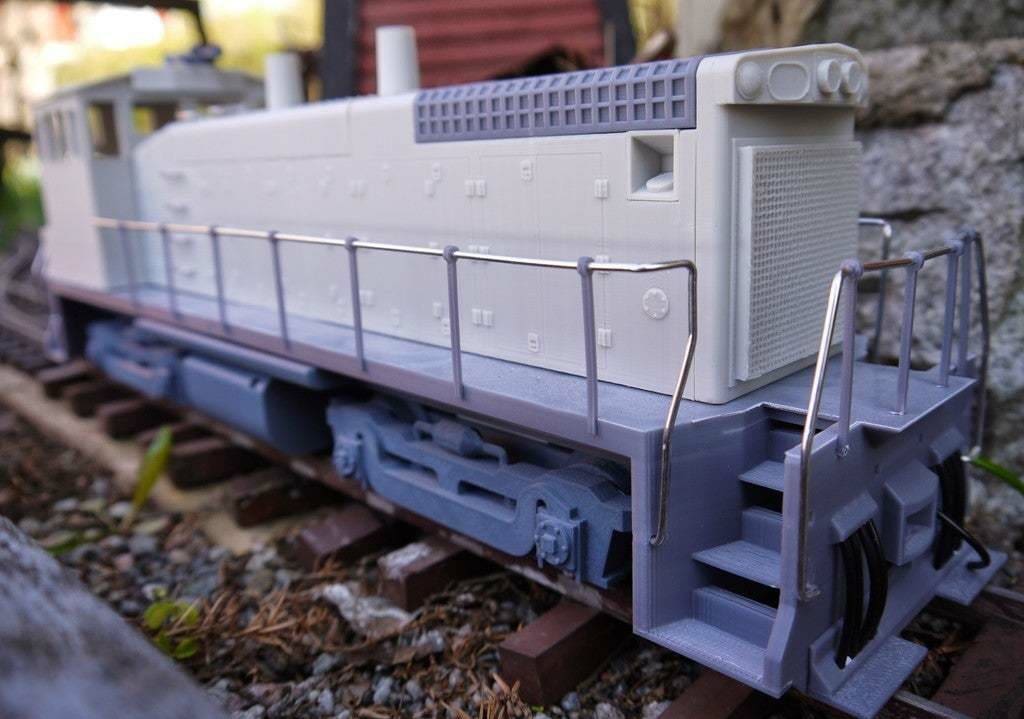
The EMD SW1500 is a 1,500 hp Diesel-electric locomotive built by General Motor’s Electro-Motive Division during the 60s and 70s. They’re still around in the United States.
Everything in this model is 3D printed except for the handrail, which is made from 1.5-mm aluminum welding rod. It doesn’t come with an instruction manual, but there’s a video that explains the whole process.
When it comes to the 3D printing settings, some users have gone as little as 0.09 mm for layer height, resulting in some very realistic results.
- Who designed it? barspin
- How printable/popular is it? This model has 21 makes and 12 remixes, so even though the model looks intimidating, you can get there.
- Where to get it? Thingiverse
- What’s the compatible train set? OpenRailway, 1:32 scale
Alphabet
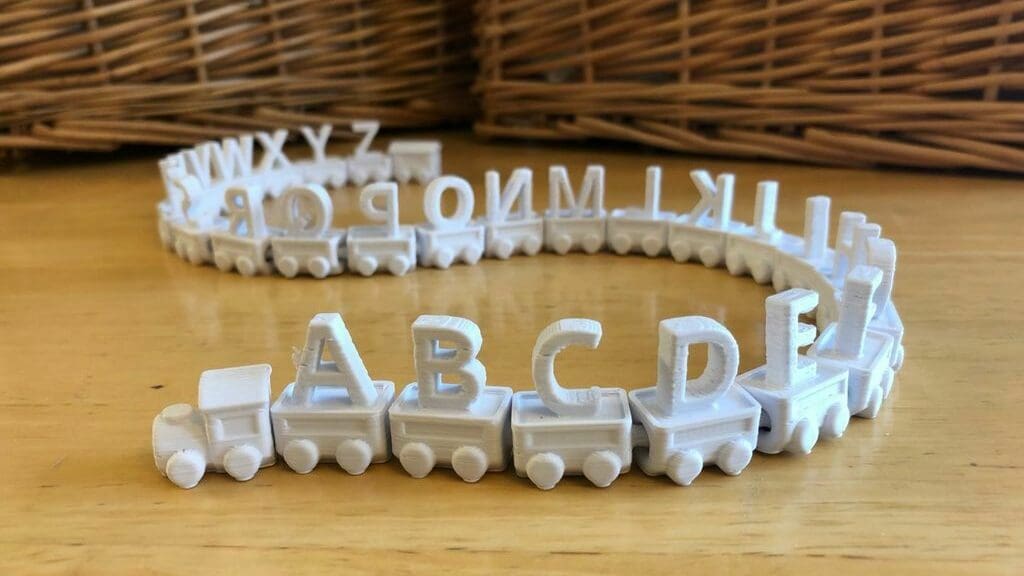
Do you want a more personalized print? It can’t get more personal than a train spelling your own name. With this alphabet train design, you could spell anything, really.
The train can be assembled in any order, and it includes an engine for the front and a caboose for the end. You can print the whole alphabet in one go, as it’s available as one STL file. Alternatively, you can print letter wagons separately, as this option of STL is also available. For the 3D printing, the creator mentions that the letters C, E, F, G, P, S, T, and Z come with and without customized supports.
Do take into account that the wheels don’t actually turn. It does slide, however, so you can still move it around.
- Who designed it? DaveMakesStuff
- How printable/popular is it? Over 10 makes and 8 remixes of this model have been shared so far. Since the creator also offers a blank wagon without any letters, the remixes include different symbols.
- Where to get it? Thingiverse
- What’s the compatible train set? N/A, no tracks needed
Lego
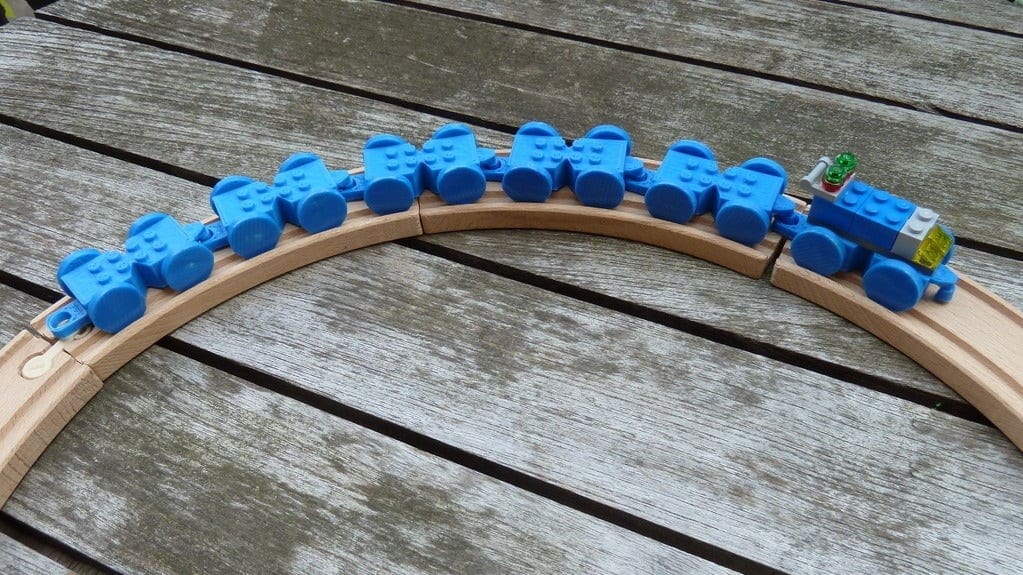
Moving on to less challenging projects, though not less fun, here’s a 3D printed train with Lego endings. You can parade your own creations around the track!
This is a very fun train, as there’s not too much to print: just the wheels and the train car(s). The latter comes with coupling in the front and rear so you can add as many cars as you wish.
As a quick printing tip, make sure your printer is calibrated correctly because if it isn’t, the Legos won’t fit.
- Who designed it? sconine
- How printable/popular is it? There are 13 makes of this model and 5 remixes.
- Where to get it? Thingiverse
- What’s the compatible train set? Brio
Duplo
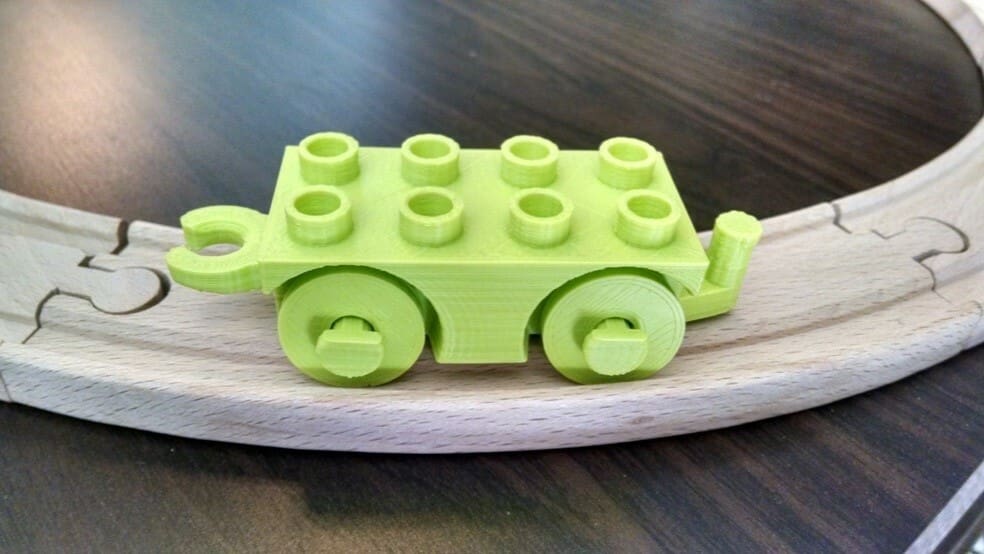
Now for some Duplo, there are a couple of options to choose from. In this selection, the wagons’ tops can be used to build with Duplo bricks. Two versions have been made that only vary in the track they can be mounted on: one is for Brio tracks and the other is for Duplo.
Duplo for Brio Tracks
- Who designed it? xtopher88
- How printable/popular is it? This model has 9 makes and 5 remixes so far; there are a 2×4 option and a 2×6 option, and the wheel bolts should snap-fit into the wagon. If they don’t, the author recommends drilling to slightly enlarge the hole.
- Where to get it? Thingiverse
- What’s the compatible train set? Brio
Duplo for Duplo Tracks
- Who designed it? joesf1979
- How printable/popular is it? With one make and two remixes, this option is for a wide wagon a 4×8, and a full train car can be printed alongside it, on top of just the Duplo brick. Note that it needs supports.
- Where to get it? Thingiverse
- What’s the compatible train set? Duplo
Balloon-Powered
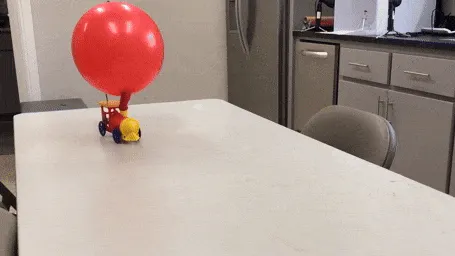
Now, this is a very ingenious and exciting print. The movement is generated by a crankshaft attached to the back wheels and powered by the air blown out of a balloon that is attached to the engine’s chimney.
You’ll need to purchase the balloon and some parts for the wheels to ensure smooth motion. This will enable the train to roll longer distances. The bigger the balloon, the longer the train goes.
A user, although they didn’t share a community print, mentioned they used 0.08 mm layer height, and sanding was necessary for some parts. The creator includes a very thorough guide on how the different parts were printed, in case you need more guidance.
- Who designed it? gzumwalt
- How printable/popular is it? This project has over 2,000 downloads and nearly 20,000 views.
- Where to get it? MyMiniFactory, Cults
- What’s the compatible train set? N/A, no tracks needed
Toy
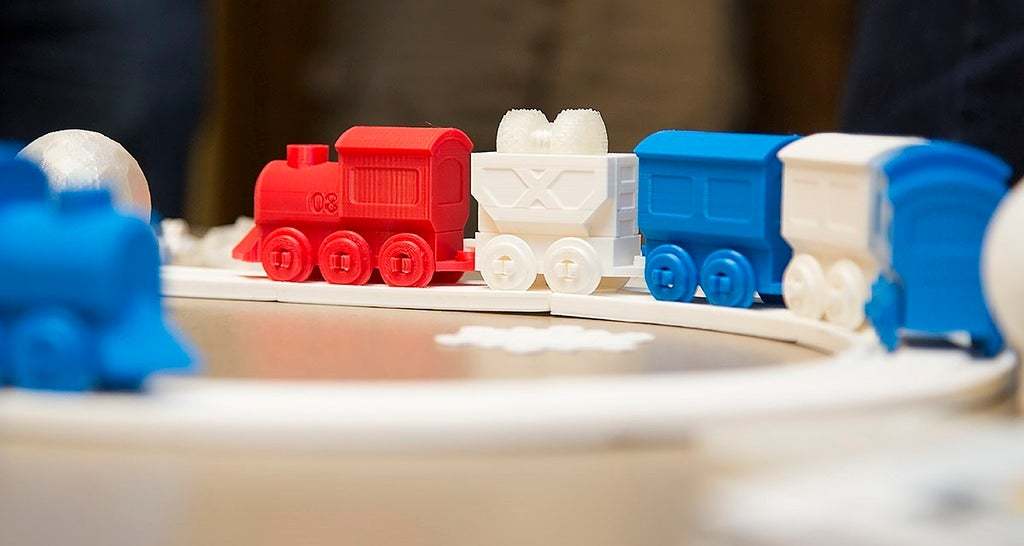
This is another easy but fun project. It’s composed of a few different parts: the locomotive, two wagon types, and the wheels. There’s also a file for the coupling-only piece so you don’t have to print the whole thing again if a part breaks.
When 3D printing, a raft can be added but isn’t necessary, and according to the author, you don’t need to use any supports at all. The wheels should be snap-fit.
- Who designed it? KrispyKevin
- How printable/popular is it? With over 50 makes and 19 remixes, it’s definitely a popular and seemingly printable option.
- Where to get it? Thingiverse
- What’s the compatible train set? Brio
Hand Car
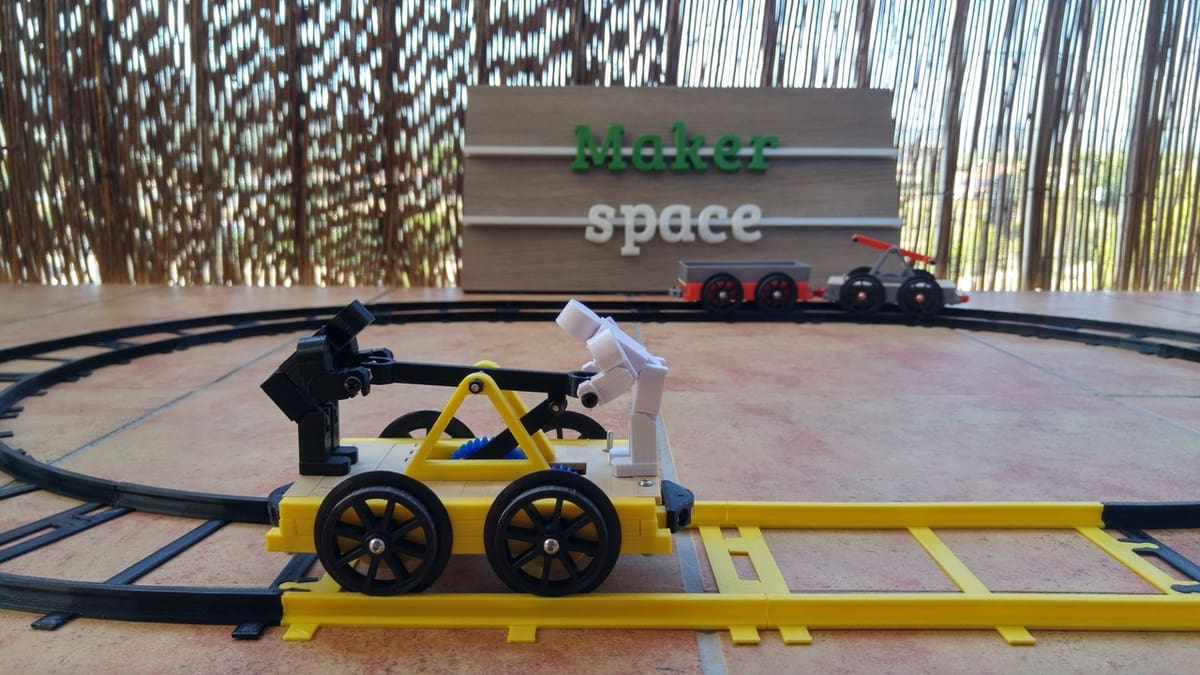
If you’re ready to take the next step with your train models, this is a great one to start with. This print consists of a quirky wagon, which two people seem to be pushing in order to cause the movement. However (and this is where some difficulty comes in), this train car is equipped with a simple, though efficient, electrical system that makes it autonomous in movement.
The model should be printed with a 0.2-mm layer height and around 20% infill. Supports aren’t needed. The files include straight and curved tracks as well as instructions for the assembly and the electronics.
Keep in mind that, for the drivers, the gap between the moving parts is very small. So, if your printer doesn’t have great accuracy, it may print them too close to move.
- Who designed it? makit
- How printable/popular is it? The project has 3 community prints and well over 1,000 downloads.
- Where to get it? MyMiniFactory
- What’s the compatible train set? N/A, printable track files included
Tracks
As mentioned before, there are some standard train set types, including Brio, Lego Duplo, and OpenRailway. Technically, you can buy the tracks for the first two, but if you want to make them yourself, we’ve included the best selection of 3D printed railways.
OpenRailway
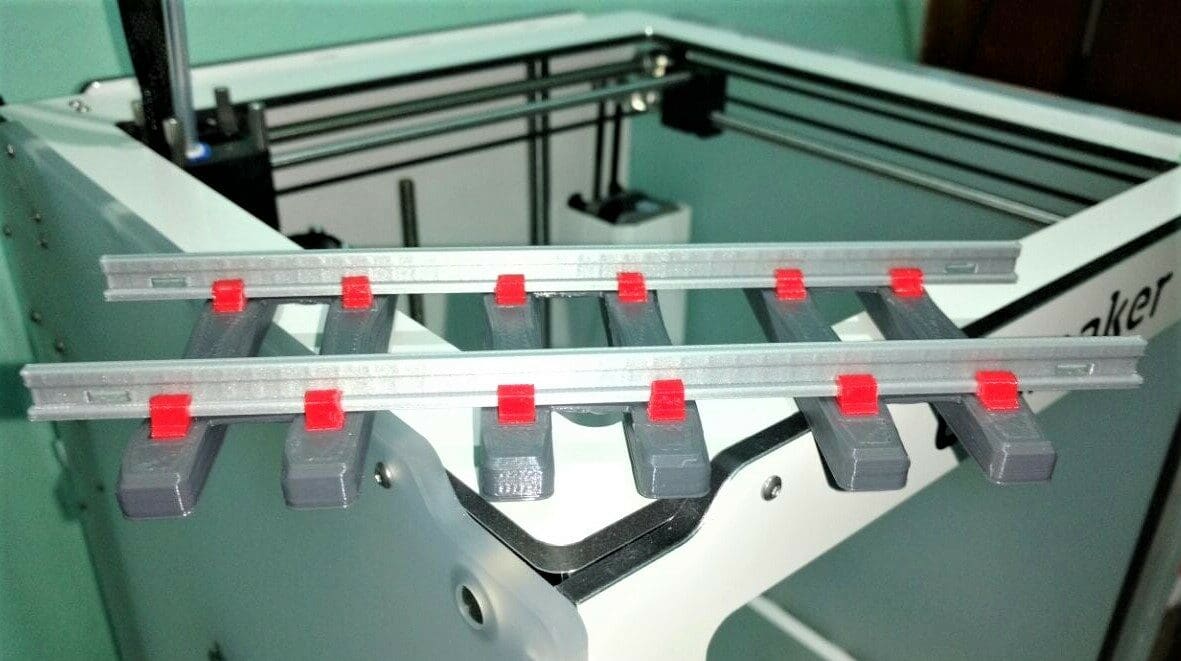
As OpenRailway consists of replicating real-life trains, often scaled down to 1:32 of the actual size, it makes sense that you’d have to do the same with the tracks. Lucky for you, we found some curved and straight OpenRailway tracks. Now, you can have your complete, life-like train set.
Straight Tracks
- Who designed it? barspin
- How printable/popular is it? So far, the model has four makes and three remixes. It’s a pretty straightforward print and the holders should be snap-fit.
- Where to get it? Thingiverse
Curved Tracks
- Who designed it? arockStone
- How printable/popular is it? This model has over 300 downloads and more than 5,000 views. It’s recommended you print in PLA with a 0.3-mm layer height and 30-50% infill.
- Where to get it? MyMiniFactory
Brio
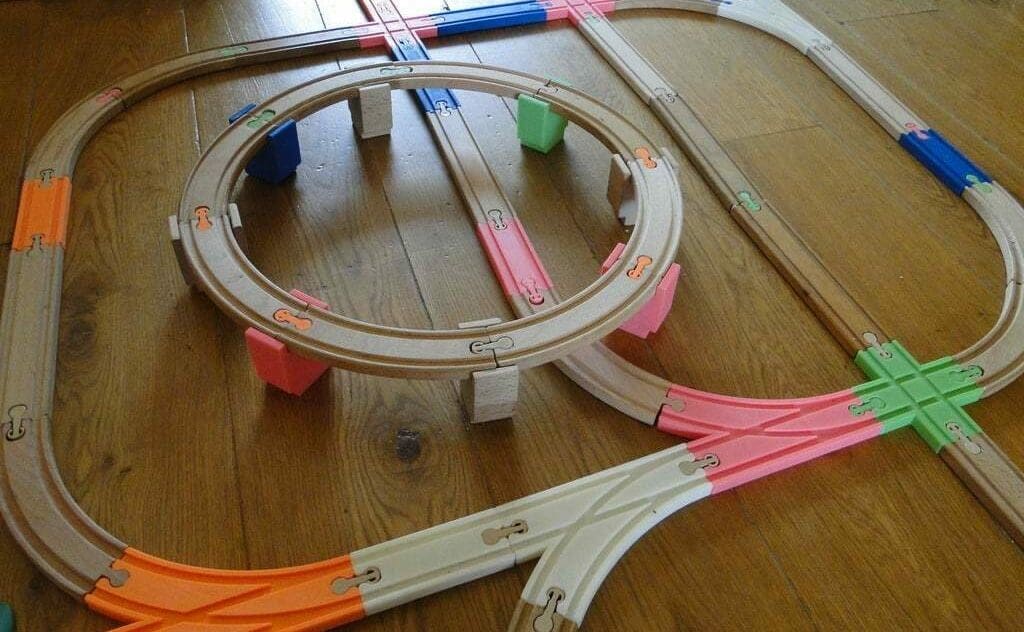
This is a perfect solution if you have an old Brio set with some parts missing and don’t want to buy the whole thing again. The model comes with straight paths, curves, and intersections!
Based on feedback from other makers, it has been tweaked and corrected, so you can rest assured that the pieces work as they should. And as most makes state that PLA was used, it should do the trick for you too.
- Who designed it? srepmub
- How printable/popular is it? There are 10 makes of different pieces from the set, as well as 11 remixes, with the T connector seeming like the most popular.
- Where to get it? Thingiverse
Duplo
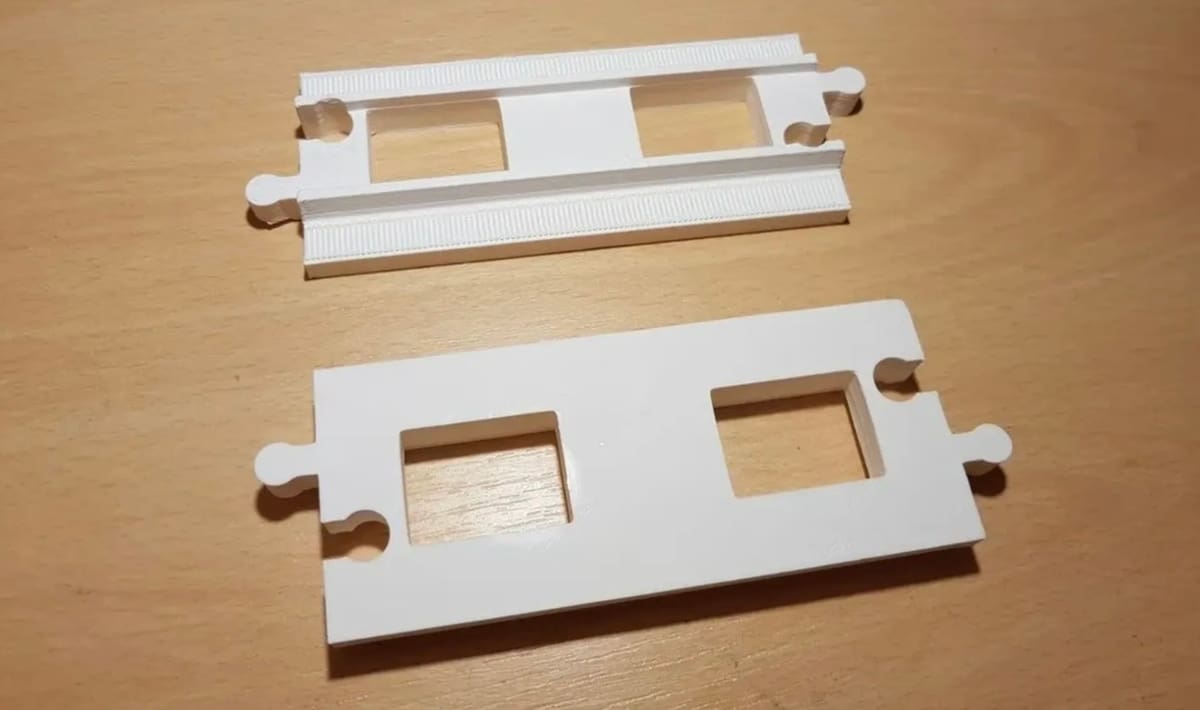
Just as with the Brio tracks, this model is useful if you have some missing pieces or if you simply want to expand your train set. Because let’s be real: A model train set can never be too long.
The individual pieces fit together by virtue of the male and female connectors. These models are easy to print and require no supports. It’s recommended that you print the parts with horizontal compensation (-0.15 mm).
Straight Tracks
- Who designed it? dziobu
- How printable/popular is it? The model has 6 makes and has been downloaded over 400 times so far.
- Where to get it? Printables
Curved Tracks
- Who designed it? pjotrx
- How printable/popular is it? Five people have shared makes of this model, along with three remixes. They suggest scaling it in your slicer to make the thin wall a little wider.
- Where to get it? Thingiverse
Lego
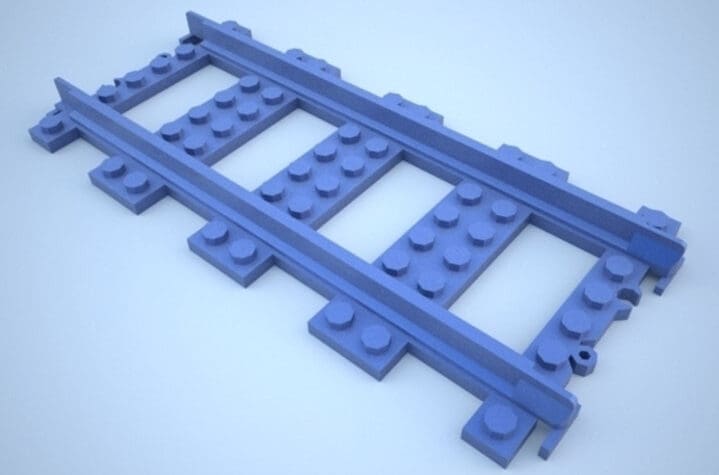
As we’re trying to cover all the basics here, it’s time to turn to another popular train set: Lego’s range of toy trains. Like OpenRailway, Brio, and Duplo, it comes with a distinct track system.
This model shouldn’t take much trouble to print, since it doesn’t require supports. Some things to look out for might be warping and stringing, as they could be the main issues to mess with the usability of this design.
As always with Lego, remember to check the tolerances; too tight a fit can be impossible to disassemble later on. Warping may be a problem but brims may not be a solution, as Lego require a high dimensional accuracy to fit.
Straight Tracks
- Who designed it? DanielNoree
- How printable/popular is it? This model has more than 26,000 views and over 170 likes.
- Where to get it? Pinshape
Curved Tracks
- Who designed it? DanielNoree
- How printable/popular is it? This model has more than 16,000 views and over 140 likes. Although it has no prints yet, the author shows their own, showing that they used ABS successfully.
- Where to get it? Pinshape
Crossings
Having many tracks that come together will give your railway new directions to go in and more space to occupy.
Turntable Crossing
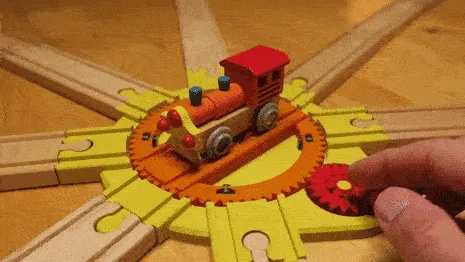
If you’re looking to make your tracks look a little fancier, this model might be just what you need. It consists of a turntable that’s moved with two gears, and the crossing offers seven different ways for your trains to go in and out. How cool is that?!
The design is customizable if you want to adjust the size of the turntable or have a different number of rail connections. The control gear, however, has a fixed size.
- Who designed it? wviterson
- How printable/popular is it? There are 15 makes of this model and 2 remixes. The designer advises inserting the wheels into the turntable gear before putting the gears on the floorplate.
- Where to get it? Thingiverse
- What’s the compatible train set? Brio
Hexagon Crossing
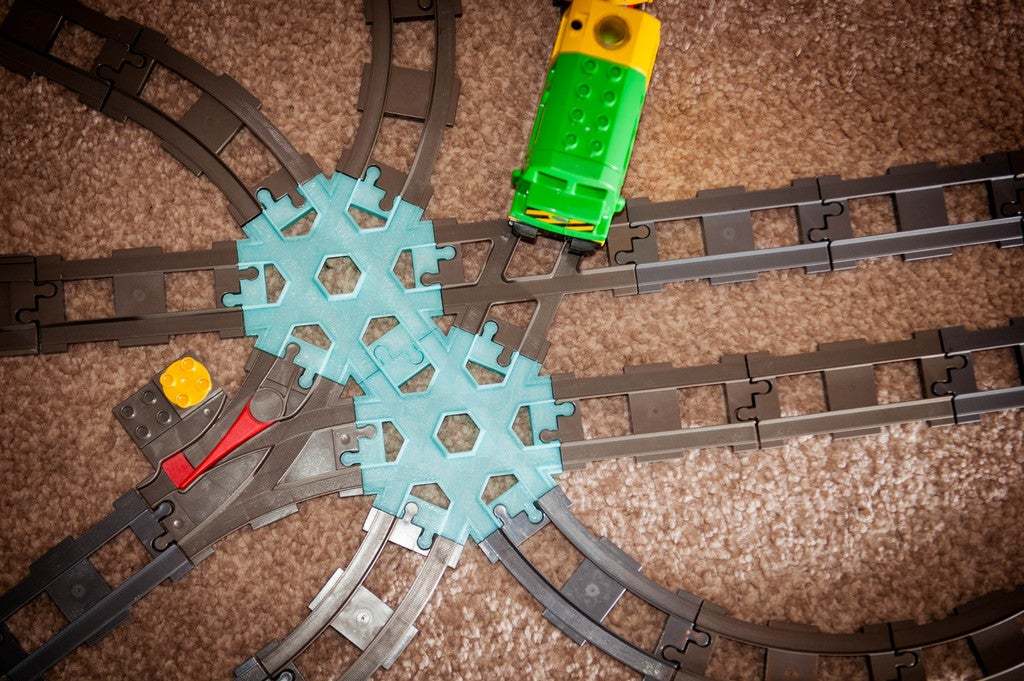
The most fun aspect of 3D printing is that you can design things that didn’t exist before. That’s the case with this hexagon crossing for Duplo train sets.
The bottom is designed so that it fits Duplo in every direction. The one shown above was printed in PLA with a 0.25-mm layer height, but if you want the ribs on the track with more detail, a lower layer height is advisable.
- Who designed it? 2by2
- How printable/popular is it? 40 people have shared a make of this model, and there’s also 1 remix.
- Where to get it? Thingiverse
- What’s the compatible train set? Duplo
8-Way Crosssing for Lego
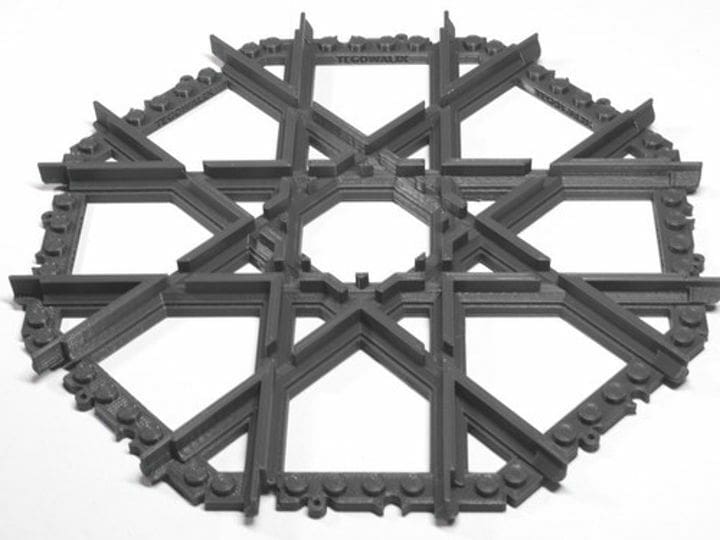
Lego tracks aren’t falling behind. With this 8-way crossing, you can connect even the most complex of Lego railway systems. It doesn’t require supports, but using brims to prevent warping may be a good idea.
Alternatively, there’s also an interesting option for a 2-way crossing that can be stacked to connect multiple crossings. This may be a suitable alternative if your Lego city isn’t as populous yet.
You can find the maker’s YouTube video with the growing options, including a 20-way crossing! Now that’s a busy city.
Crossing for Wooden Trains
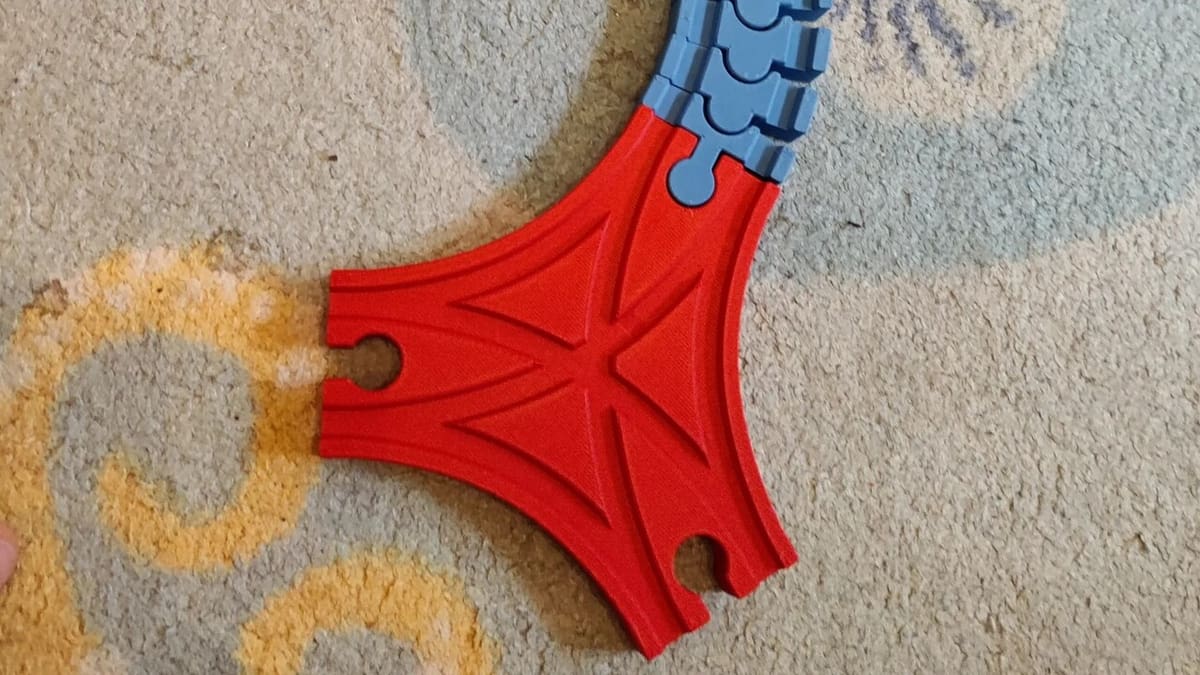
The Triangular Crossing Train Track for wooden trains is versatile, allowing three tracks to be joined seamlessly at 120-degree angles. It’s designed to fit with popular wooden train sets like Ikea, Brio, Bigjigs, other 3D printed tracks, and more, making it a great addition for expanding any train layout.
While some users mention that deeper tracks could enhance stability, the general consensus is that this track piece works exceptionally well. It adds complexity and fun to wooden train systems, allowing for more creative and dynamic routes.
- Who designed it? dachu02
- How printable/popular is it? According to MakerWorld, there are over 140 makes of the model, while the design has been downloaded over 160 times.
- Where to get it? MakerWorld
- What’s the compatible train set? Ikea, Brio, Bigjigs, other wooden and 3D printed train tracks
Extended Set
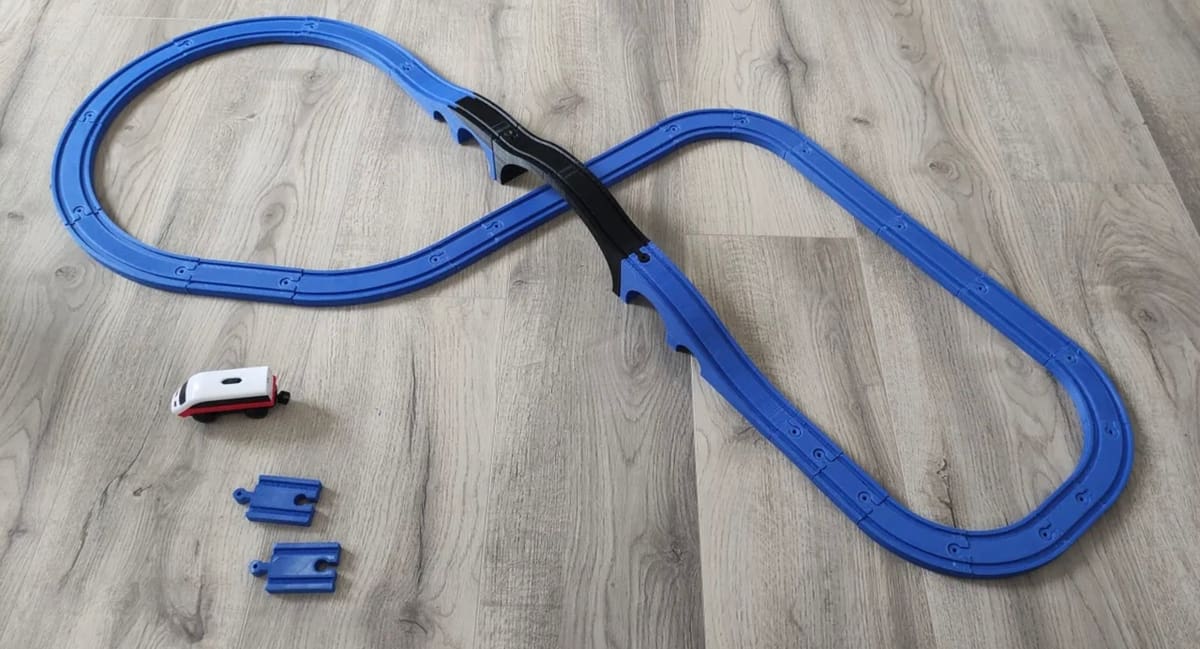
The Extended Set of Wooden Train Track with 50+ Unique Pieces is a fantastic addition for any wooden railway enthusiast. This comprehensive set includes straight tracks, curves, switches, crossings, and bridges, offering endless possibilities to expand your train set.
Compatible with popular wooden train systems, it brings versatility and creativity to your layouts. While some users point out that the bridge isn’t tall enough for trains to pass under it comfortably, this minor issue doesn’t detract from the overall quality and value of the set. The variety of pieces makes it a perfect choice for building more complex and engaging train routes.
- Who designed it? MichalFanta
- How printable/popular is it? There are over 90 makes of these designs. The designer says that all tracks can be printed on a build plate the size of Prusa’s MK4.
- Where to get it? Printables
- What’s the compatible train set? Brio
Bonus: Two-Way Lego Switch
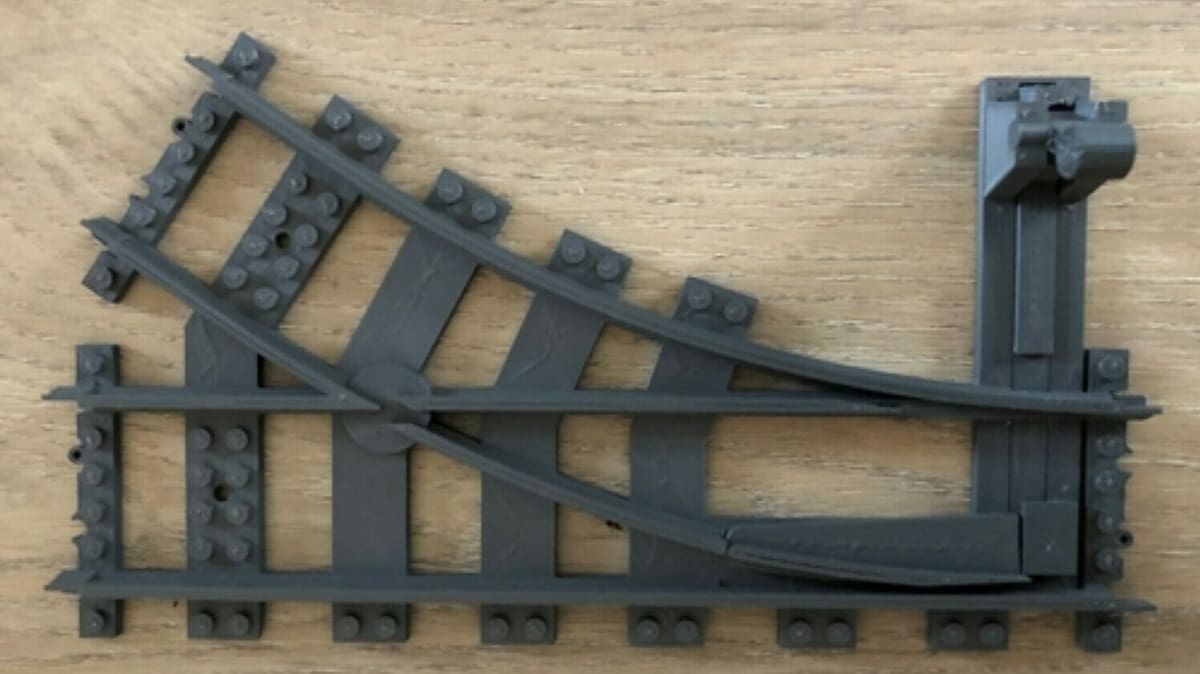
Now, let’s add some toys to that Lego circuit, although know that this design has a price tag attached. This is a two-way divisor, but it has more magic than that. It has a working switch so you can choose which lane takes precedence, giving you full control of the track’s direction. If you’re ambitious enough, you could even automate it.
Similarly to these types of models, the tracks are easy enough to print as long as your printer is well-calibrated. However, keep in mind that good printing quality is needed to make the switch work correctly, as its parts are quite small. Even a tiny bump can make a difference. The creator recommends a resolution of 0.2 mm and a print speed of 60 mm/s for a good fit.
- Who designed it? by ctrl design
- How printable/popular is it? This model has more than 9,000 views and 6 likes.
- Where to get it? Pinshape
- What’s the compatible train set? Lego
Bonus: Four-Way Lego Crossing
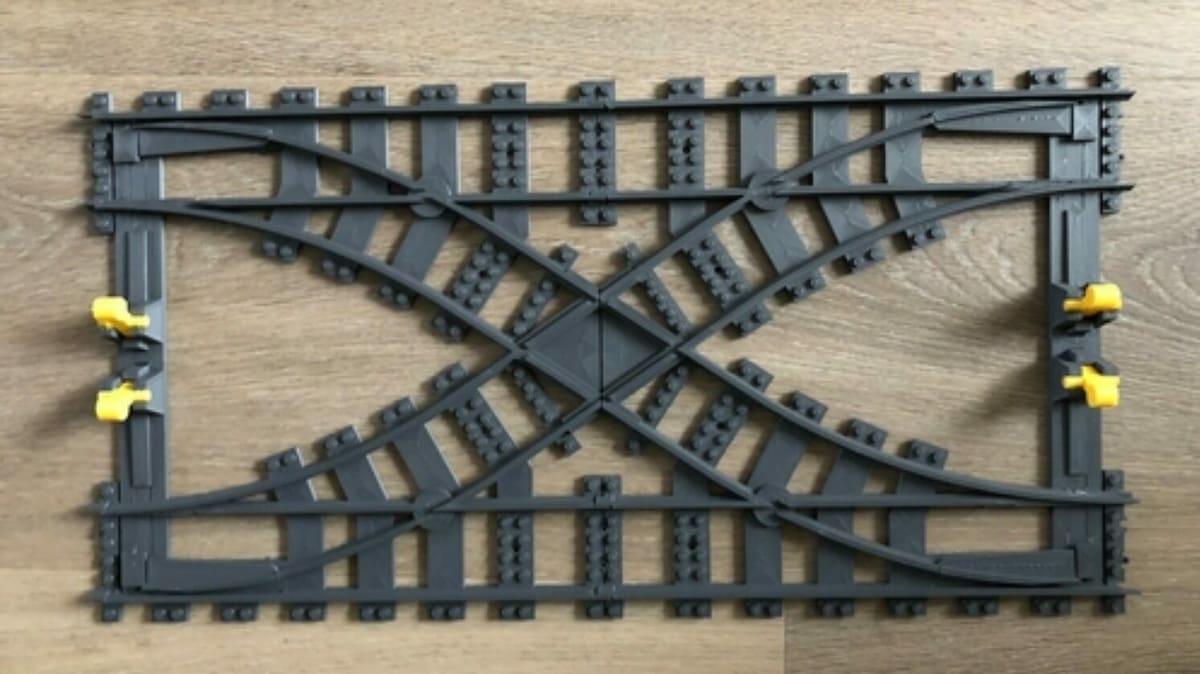
If you think two-way crossings are fun, get ready for four! Double the crossings, double the fun – and probably also double the printing time. With straight, curved, and many crossing types, your Lego track is honestly ready to reach space.
Also purchasable, all parts are printed separately, including the straight and curved tracks, and assembled together. The creator has provided instructions on how to assemble the switch and be sure to follow them closely because once the switch is assembled, it can be near impossible to disassemble. The creator opted for PLA, but if you’re going to be assembling and disassembling other Legos onto the track, you may have to look out for wear and tear.
- Who designed it? by ctrl design
- How printable/popular is it? This crossing has over 5,000 views, as well as 8 likes.
- Where to get it? Pinshape
- What’s the compatible train set? Lego
Accessories
These are a selection of extra pieces that you don’t necessarily need in a train set, but that you can incorporate to make your set more unique and more fun. Most of the accessories featured below are for Brio tracks, as they’re the more popular type, but there’s something for Team Lego too.
Brio Rocker
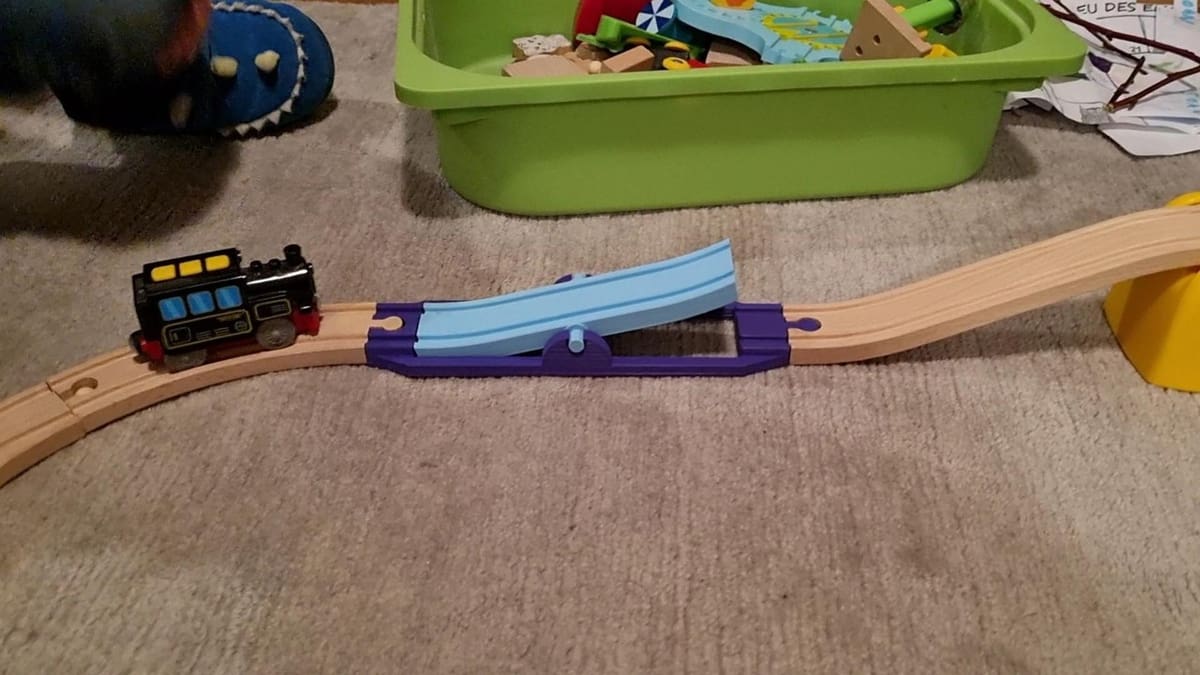
Does your train track need this? Probably not. Will it look awesome with it? Absolutely! This simple but smart mechanism uses the weight and speed of your own train to add a bit of adrenaline to its path. The rocker only works, though, if your engine is going at a high enough speed to make the trek up, so it’s recommended to put it after a slide.
The model is a bit long, as the creator calculates that you’ll need a printing space of at least 265 mm. That being said, you can also consider positioning it diagonally or splitting the print in two, if it comes to that.
- Who designed it? flexman
- How printable/popular is it? This model has nine makes and two remixes. And if your printer can’t fit it, there’s a remix where the base has already been divided in two.
- Where to get it? Thingiverse
- What’s the compatible train set? Brio
Train Tunnel
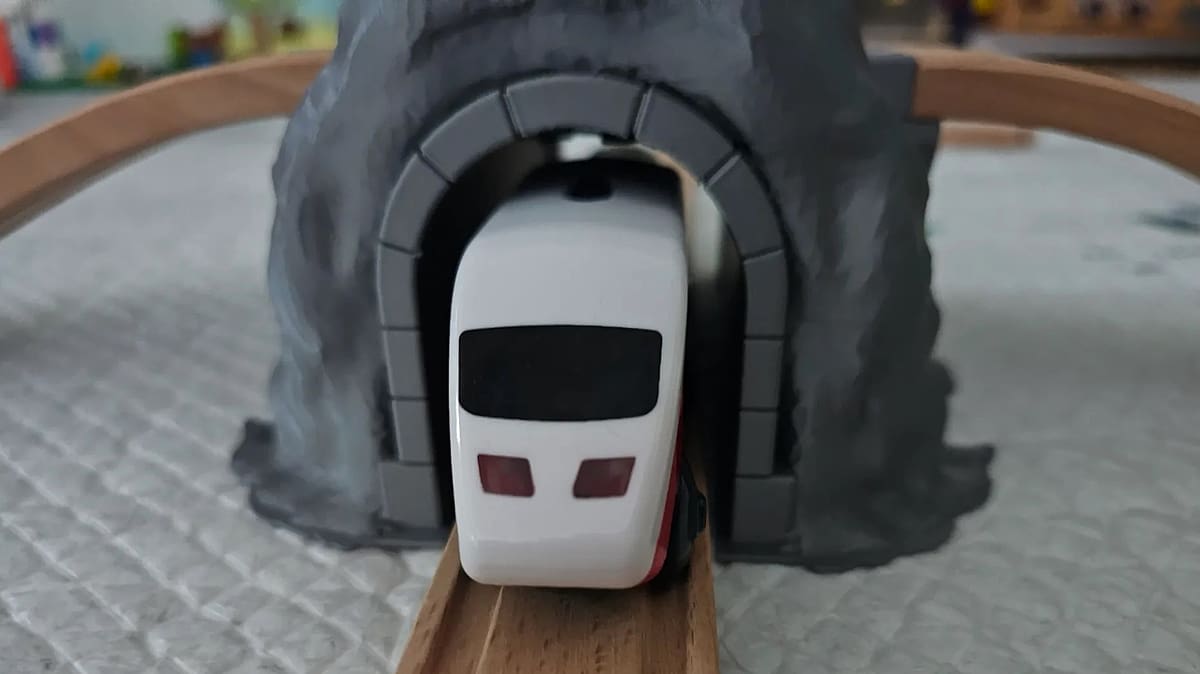
The Train Tunnel compatible with Ikea and Brio wooden trains is a beautifully designed rocky tunnel that adds a diorama-like feel to any wooden track setup. It features an integrated perpendicular bridge, enhancing the layout’s complexity and fun.
This remixed design has removed sharp edges to make the print safer and more suitable for kids, ensuring it’s a child-friendly accessory. The tunnel not only provides a more realistic and imaginative play experience but also adds visual appeal to the track system, adding an extra layer of excitement to wooden train adventures.
- Who designed it? snajderos
- How printable/popular is it? This model has over 160 makes. Make it add a scenery feel to your train set.
- Where to get it? MakerWorld
- What’s the compatible train set? Ikea, Brio
Brio Track Spacers
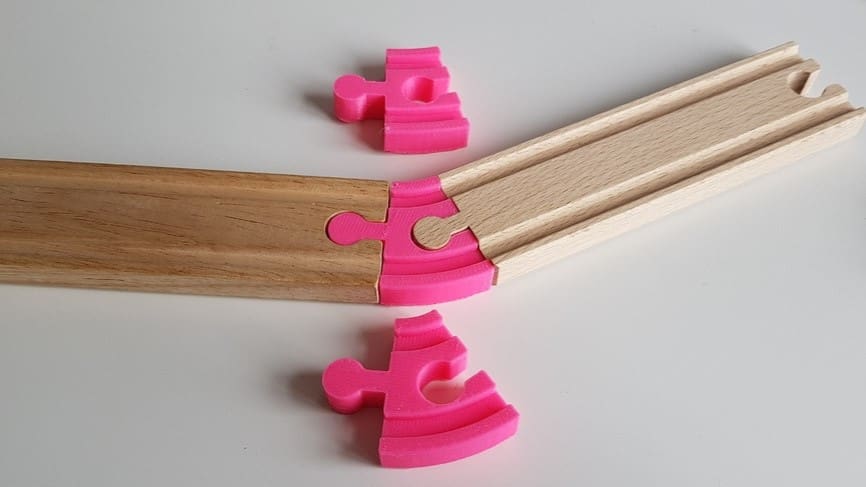
These spacers are used for two purposes. First, you can achieve curves using only straight tracks and these adapters. Second, the spacers can be used to connect tracks that may have an angle mismatch. Instead of trying to force the two rails together, placing a spacer between them prevents unnecessary stress that could result in damage to your pieces.
Requiring neither rafts nor supports, this is a pretty easy print.
- Who designed it? MrMilu
- How printable/popular is it? Five makes and one remix have been posted so far.
- Where to get it? Thingiverse
Brio Bridge Adapter
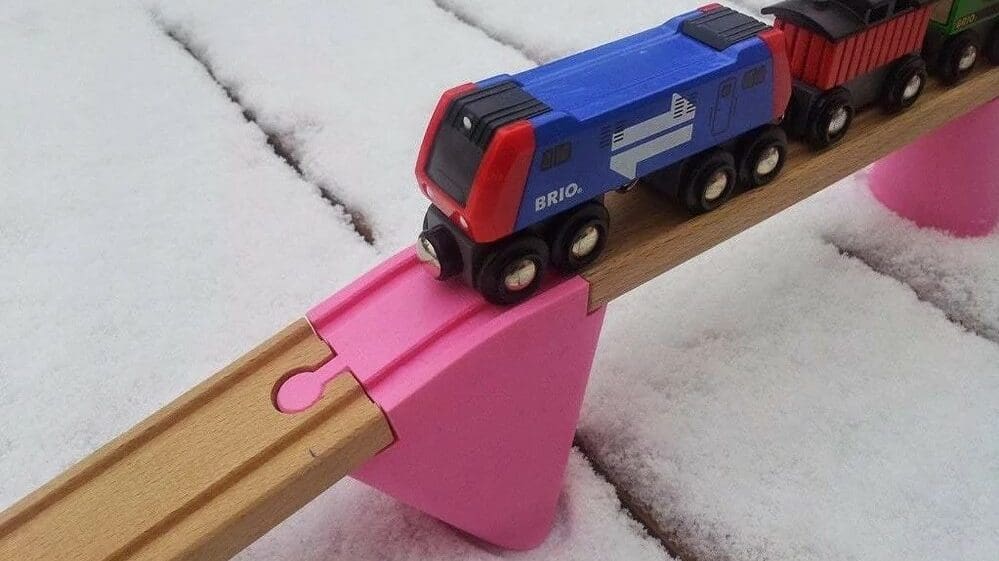
Toy tracks can’t always run on the ground. What if there are toy rivers or toy houses in the way?
This is a set of various parts that you can put together to create a bridge. The height of the bridge is fixed, but it can be however long you’d like thanks to several parts on offer. Some of the parts even come with pads to make printing easier.
- Who designed it? zypher
- How printable/popular is it? 26 people have shared a make of this bridge, and 4 have remixed it. Despite the name of the Thingiverse post, users recall that it fits with Brio, but with Ikea tracks it leaves a small gap, so although it works, it’s not a perfect fit.
- Where to get it? Thingiverse
Lego Duplo Train Bridge
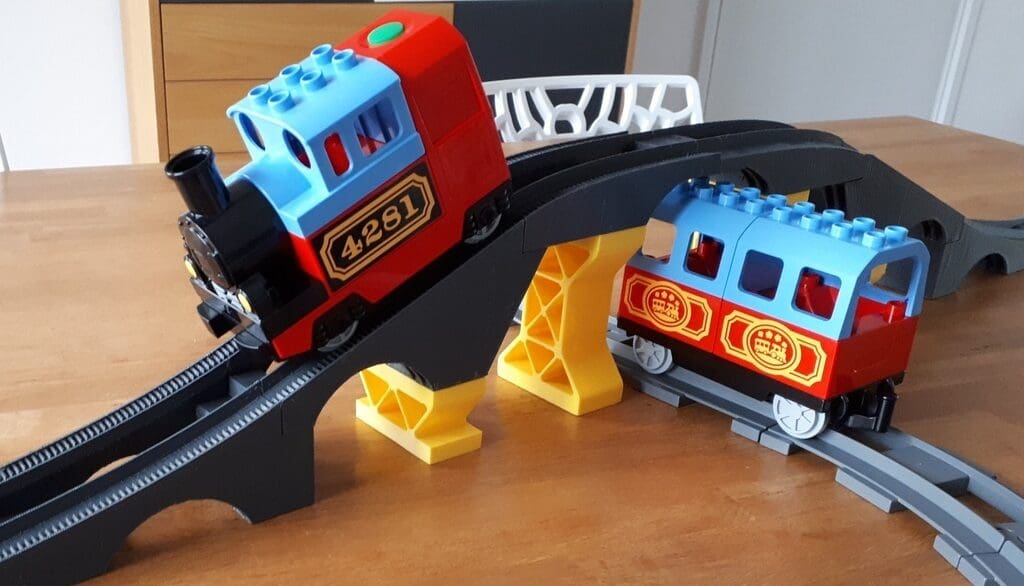
Let’s not leave Duplo behind. This Duplo bridge can be used in conjunction with the corresponding bricks to build bridges of any height. You can build a standard bridge or keep stacking upwards to reach new heights like some people in the makes have done.
Additionally, even the smallest height can pass a Duplo wagon, thanks to the smart shape the creator has included in the model. As the maker recalls, the bridge has a length of seven standard straight track lengths.
According to makers, it doesn’t need supports and 15% to 30% of infill should do the trick.
- Who designed it? advancedvb
- How printable/popular is it? This model has 4 makes and some of the files have been downloaded over 12,000 times.
- Where to get it? Thingiverse
- What’s the compatible train set? Duplo
Brio-to-Duplo Converter Brick
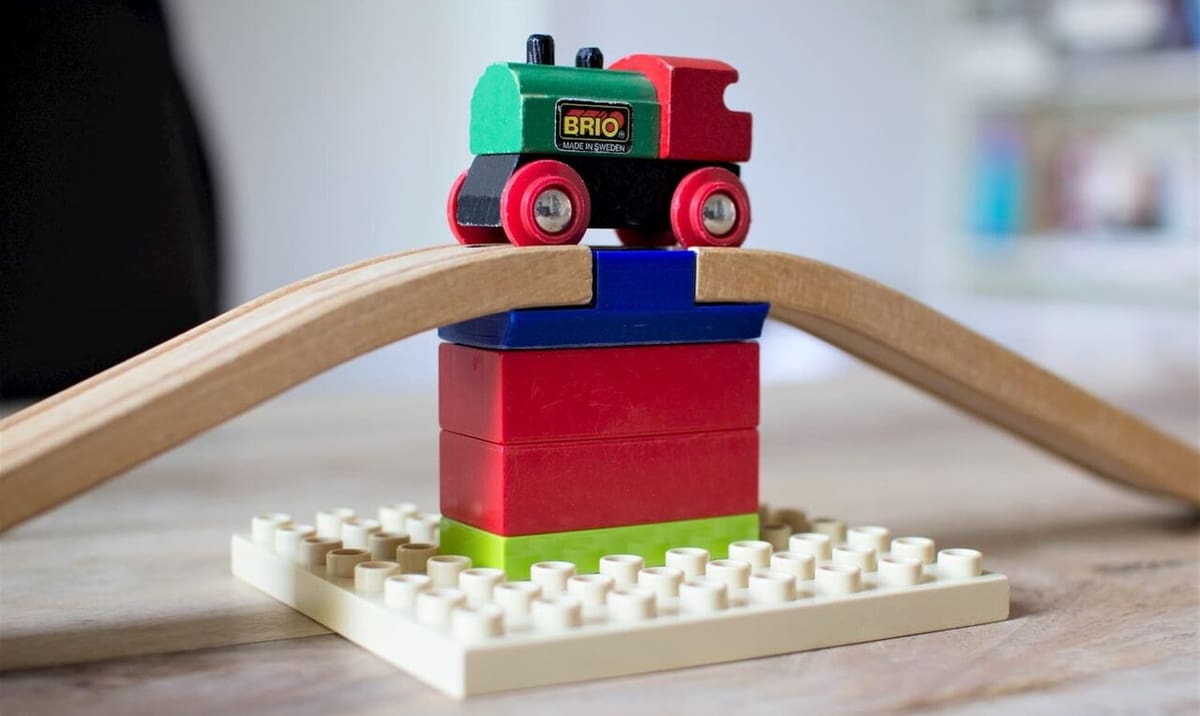
With Lego Duplo, you can experiment and personalize your railroad. It allows for countless possibilities in terms of shapes and heights. This model by Thingiverse user flummer allows you to combine Lego Duplo bricks with Brio tracks. This ingenious design allows you to attach Duplo bricks below the rails, making bridges however tall or short you like.
When it comes to 3D printing it, if you place it with the bottom face facing upwards, it doesn’t need any supports.
- Who designed it? flummer
- How printable/popular is it? Over 60 makes have been shared of this model, along with 11 remixes.
- Where to get it? Thingiverse
Brio-Compatible Lockable Switch
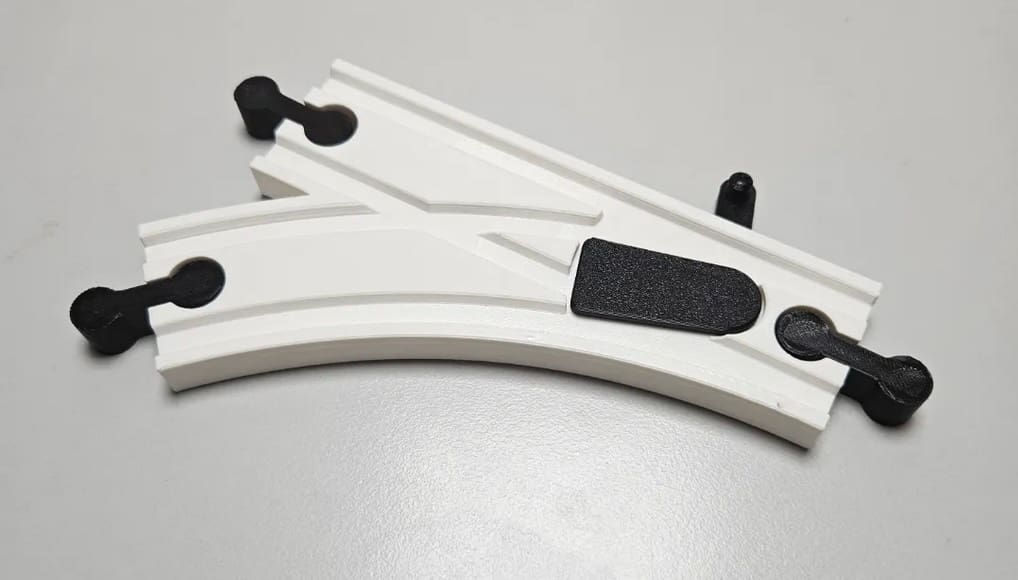
The Brio Compatible Lockable Switch is a manual mechanical switch designed to control train movement between two tracks, featuring a spring-based mechanism for smooth operation. The parts are assembled using a snap joint, making it easy to assemble and durable for play.
This model is an improved version of a previous one, and it addresses the issue of heavy trains that accidentally moved the switch. Now, the switch locks in place, preventing unintended shifts while still being easy for children to operate manually. This accessory adds even more interactivity and fun to any wooden train set, ensuring smoother play. It’s a smart upgrade for those looking to enhance the functionality and reliability of their train system.
- Who designed it? RyeBread
- How printable/popular is it? This model has over 30 makes. This mechanical switch adds lots of interactivity to the train set.
- Where to get it? MakerWorld
- What’s the compatible train set? Brio
Flexible Brio Track
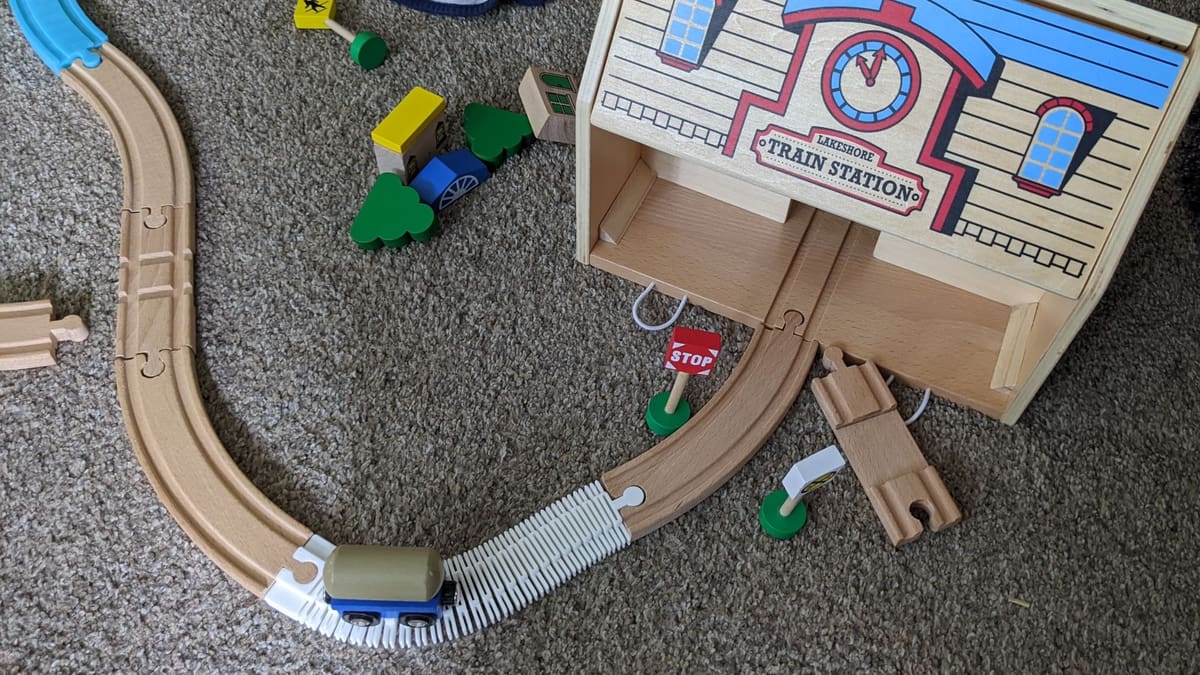
This model is a great example of how 3D printing can give an existing design new powers, which in this case is flexibility. These tracks can be curved, straight, in an ‘S’ shape, or any way you’d like them to be! The model can also be easily adapted for different lengths.
Comments recall that printing in PLA worked well, so the material should hold well enough – unless you want to add even more flexibility and go the TPU way.
- Who designed it? atartanian
- How printable/popular is it? This print has 11 makes and a whopping 103 remixes.
- Where to get it? Thingiverse
Complete Projects
For those experienced makers who are looking for more complex and time-consuming projects, we’ve compiled full projects that range from technical difficulty to precision in painting and assembling.
Thomas & Friends
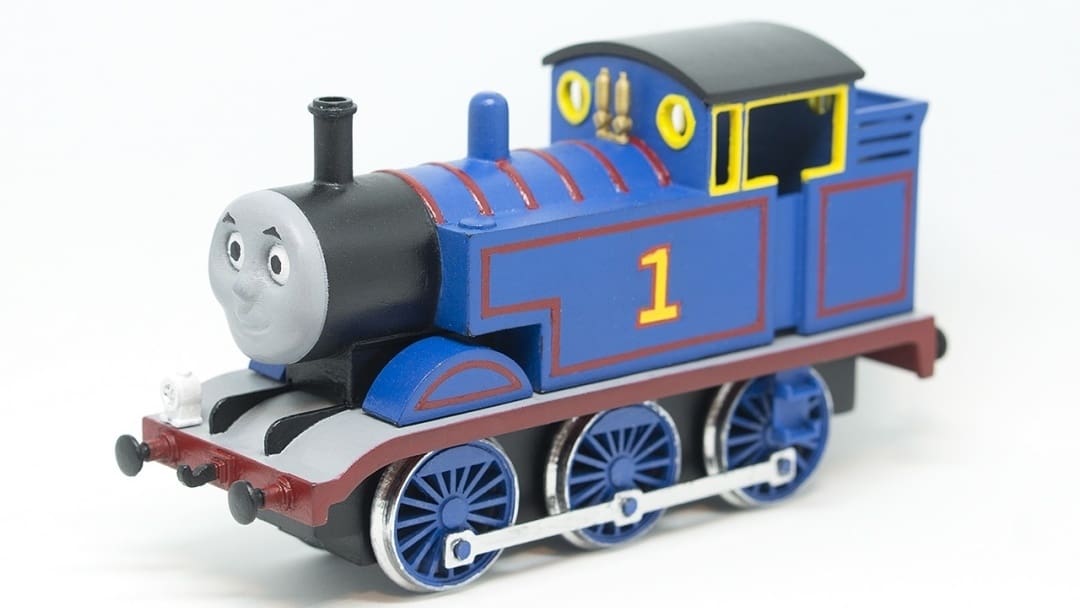
It’s time to go on a trip to the past with this Thomas and Friends collection. The set includes Thomas, Annie and Clarabel, and Bulgy the double-decker bus as well as the tracks. Each character is composed of multiple parts that have to be painted and assembled to complete the whole look. It seems like a very entertaining project that has a nostalgic factor and makes for a great gift to the young ‘uns in your life.
- Who designed it? agepbiz
Thomas
- How printable/popular is it? With over 28,000 views and more than 2,000 downloads, the model is obviously the most popular in the collection. You may have to do some smoothing if you want your print to look as good as the one in the picture.
- Where to get it? MyMiniFactory
Annie and Clarabel
- How printable/popular is it? These two models come in a matching set and have over 900 downloads and nearly 14,000 views. All the pieces require supports, and except for the wheels, a 40% infill is recommended. The wheels should be printed with a 100% infill.
- Where to get it? MyMiniFactory
Bulgy
- How printable/popular is it? This model has more than 900 downloads and nearly 13,000 views. As it has fewer parts to print, paint, and assemble, this is an easier print than the previous three.
- Where to get it? MyMiniFactory
Tracks
- How printable/popular is it? The rails have over 400 downloads and more than 9,000 views. As with most of the track designs we’ve listed, supports aren’t required.
- Where to get it? MyMiniFactory
Dragon Railway
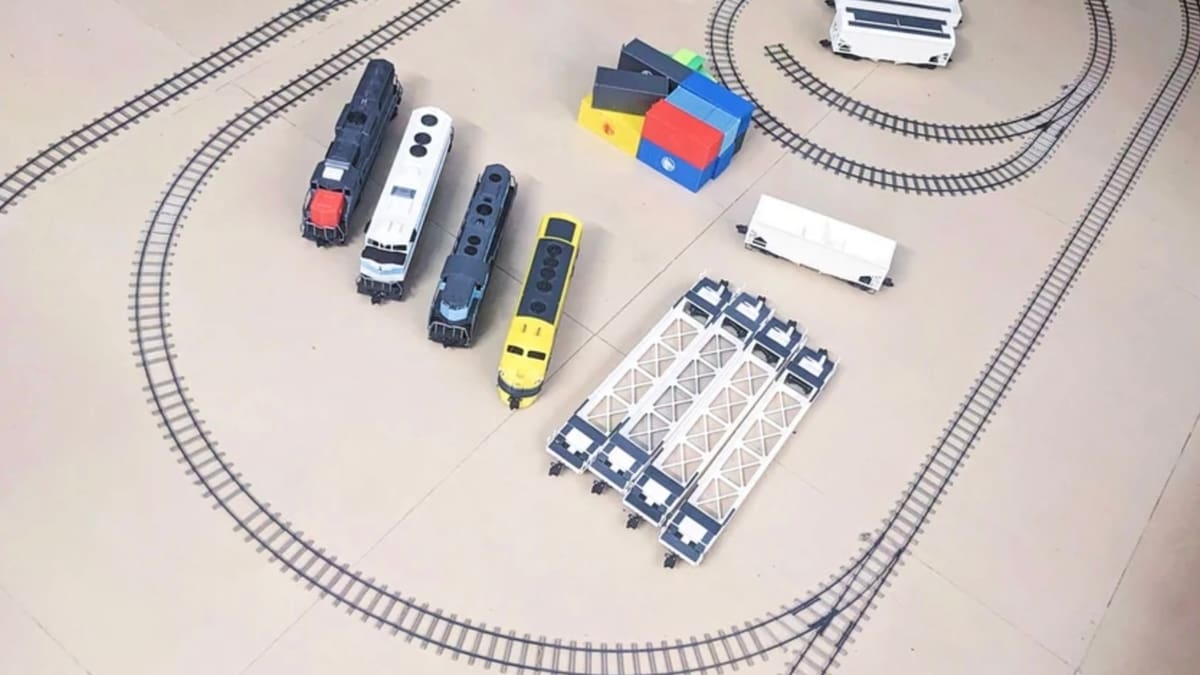
The Dragon Railway is an impressive project, encompassing a complete open-source ecosystem, focused on creating a highly detailed and accurate scale model of a railway system. It includes everything from locomotives and wagons or rail cars to tracks, control systems, and various accessories.
Using Fusion’s parametric design features, you can fully customize your railway layout, adjust track lengths, and curves, or even create your own custom tracks. This flexibility makes it a standout option for railway enthusiasts who enjoy hands-on creativity.
The 1:64 scale system is designed for easy assembly, and several realistic models of locomotives and wagons are already available for 3D printing, adding authenticity to your railway setup. Whether you’re an experienced modeler or just starting out, Dragon Railway offers a versatile and accessible way to bring your dream railway to life. It’s a fantastic open-source solution for hobbyists looking for a detailed and customizable model railway experience.
- Who designed it? Rambros
- How printable/popular is it? This open-source ecosystem has over 70 comments of users that share their makes, questions, learnings, and achievements through the Instructable.
- Where to get it? Instructables
Christmas Train
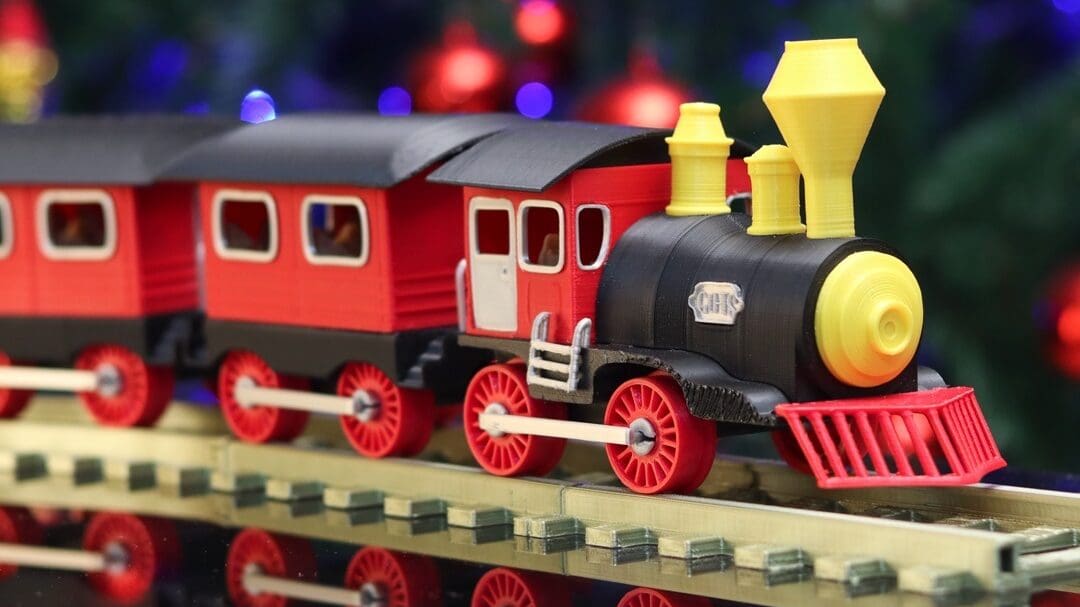
Add this to your To-Print List for next Christmas so that you make it on Santa’s Nice list!
A must-have around any Christmas tree, this is a beautiful and jolly – you guessed it – Christmas train.
The set includes the locomotive, wagons, and rails. For the rails, there are three types: one straight and two curved, one at 45° and the other at 90°. It also includes details for the interior of the wagons, such as seats, making it a model beyond admiration for kids and adults alike.
For FDM 3D printing, the creator scaled up by 150% to better show the details. You’ll have to see what final look you want and what resolution your machine can replicate before deciding on the scale.
Prusa Set
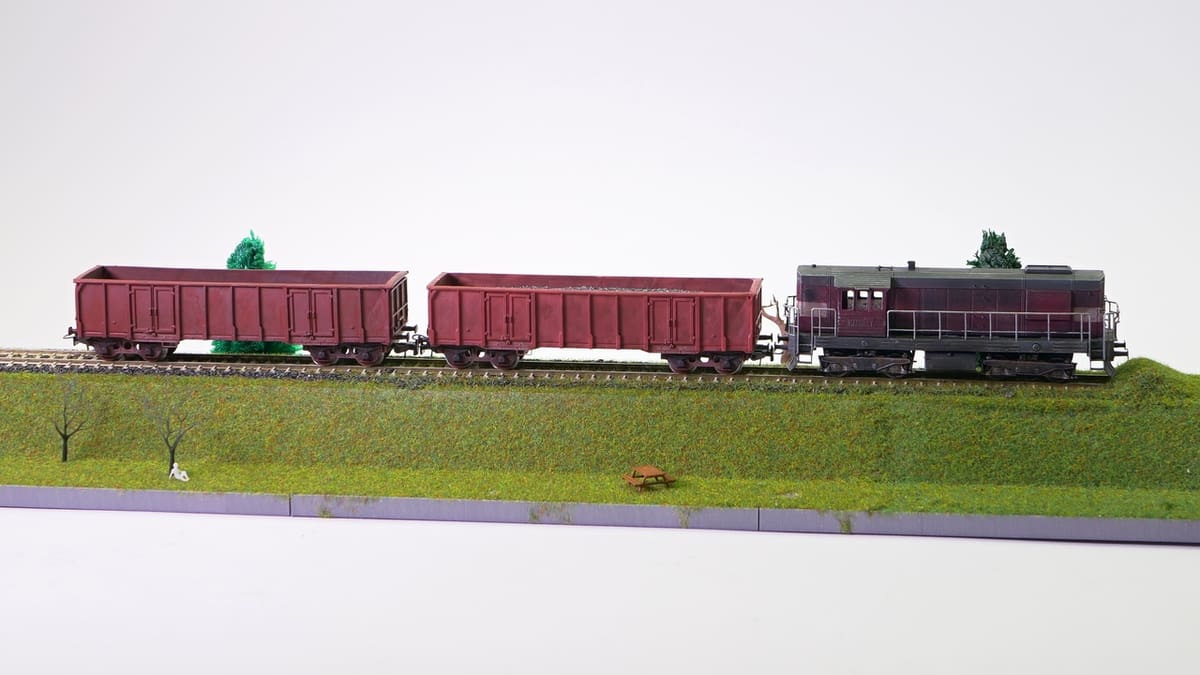
The Prusa Research Blog features a series of articles that cover how to make a model train set with everything from the landscape to wagons and buildings. The trains in the article are printed in resin (which you can also paint), but they can also be printed on an FDM machine with a 0.4-mm nozzle and 0.15-mm layer height.
Printer settings depend largely on the model, but the Printables blog entry goes in great detail for each.
- Who designed it? Jakub Kočí
- How printable/popular is it? The parts on Thingiverse have 15 makes and 3 remixes in total, and most of the parts on Printables have thousands of downloads, with 11 makes altogether.
- Where to get it? Prusa Research Blog
OS System
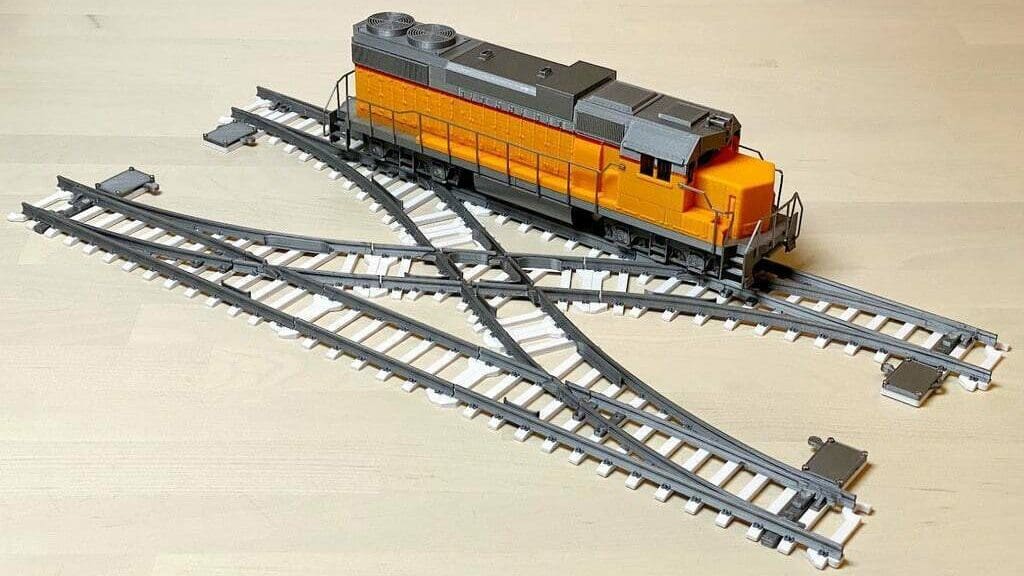
This is an open-source project that was created for the purpose of making a fully 3D-printable system that doesn’t need any commercial train hardware except, of course, for motors and electronics.
The project has tons of different locomotives and comes with its own set of railways, bridges, and slopes. You also get clear instructions to assist you with the electronic assembly process.
- Who designed it? Depronized (Olle Sköld)
- How printable/popular is it? There are currently 43 designs associated with this project on Thingiverse’s project group. Some have makes, while others don’t. In some cases, whenever you see elements such as handlebars for the wagons, those are made from bent, unmelted filament; quite ingenious.
- Where to get it? Thingiverse (STLs), Cults (STLs), YouTube (tutorials)
License: The text of "3D Printed Trains & Railways: The 30 Best STL Files" by All3DP is licensed under a Creative Commons Attribution 4.0 International License.


